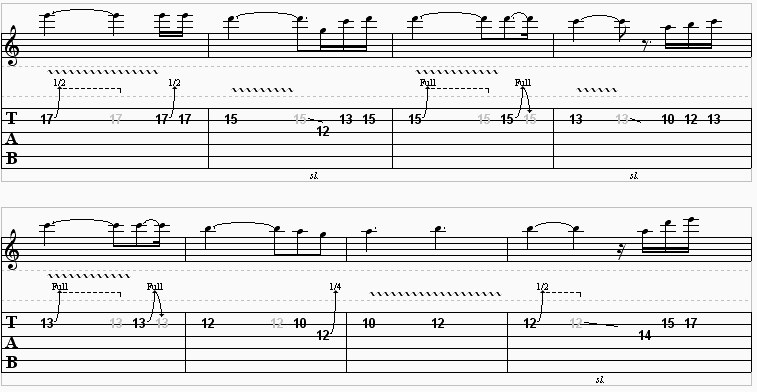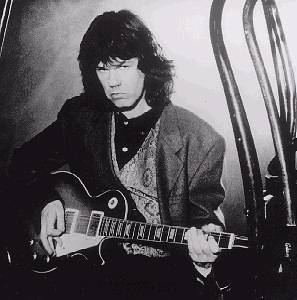“Still Got The Blues” is known for its soaring guitar solos, some of which are not hard to play.
Release Date – May 1990
One of rock’s most underrated guitarists, Gary Moore remains relatively unknown in the U.S., while his solo work has brought him substantial praise and commercial success in most other parts of the world, especially in Europe. Born on April 4, 1952, in Belfast, Ireland, Moore became interested in guitar during the ’60s, upon discovering such blues-rock masters as Eric Clapton, Jimi Hendrix, and his self-proclaimed biggest influence – Fleetwood Mac.
Intro Solo
Here’s what the intro solo sounds like with the rhythm and bass guitars:
Guitar 1
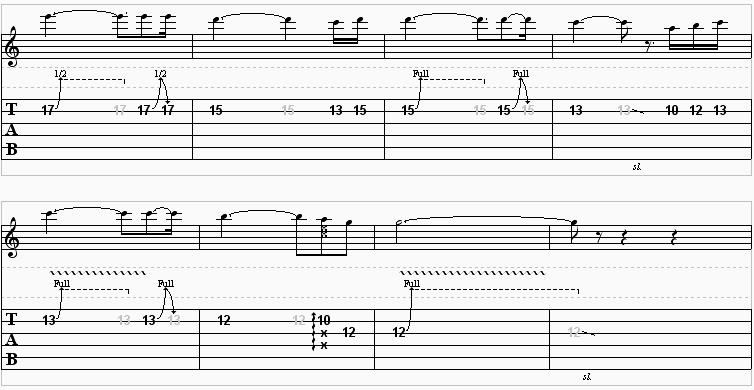
How To Play It
These series of riffs from Still Got The Blues is definitely challenging. You will begin the first measure by performing a 1/2 bend. The good news is that for the first measure you will only be playing this note continually and bending it. The bad news is it gets much harder. Notice that this guitar part is the lead part. Use your 3rd finger to bend this note. Notice the dotted lines at the end of the first seventh fret during the bend. This will signify to you to hold the bend until you begin the next picking transition.
For the second measure, you will be using your 2nd finger to play the fifteenth fret on the “B” string. This finger is used because you will need to use your 1st finger for the next part. After you have played the fifteenth fret, simply use your 1st finger to play the thirteenth fret on the same string. End the measure by using your 2nd finger again on the fifteenth fret. For the third measure, you will be bending the fifteenth fret, which your finger should still be on, one full bend. Do this twice for the measure, and remember to use your 2nd finger.
The next measure is pretty easy. All you will be doing here is playing the thirteenth fret with your 1st finger and then slide to the tenth fret with the same finger on the same string.
Next, just move the same finger on the same string to the twelfth fret, followed by the thirteenth fret again. In the next measure, you will be bending the “B” string on the thirteenth fret one full bend, and immediately providing some vibrato in the process. To use vibrato, all you need to do is rapidly shake the string that you are playing until the desired time to stop, or before the next note. All you will do for the remainder of the measure is bend the same string again.
For the next measure, use your 1st finger to play the twelfth fret on the “B” string, and then move it to the tenth fret on the same string. Notice here that you will have two mutes on the “G” string and the “D” string. You will play those at the same time, as well as the tenth fret on the “B” string. Now, the vertical line going down the strings on the tablature indicates that you will be raking the strings rather roughly, so make sure to do this with your pick.
End the measure by placing your 1st finger on the twelfth fret on the “G” string to prepare for the next measure’s bend. Don’t forget to play it once for good measure. In the last two measures, you will need to first bend the “G” string on the twelfth fret once one full bend, and add some vibrato in there as well.
End the next measure by sliding toward the tuning pegs on the guitar.
Guitar 2
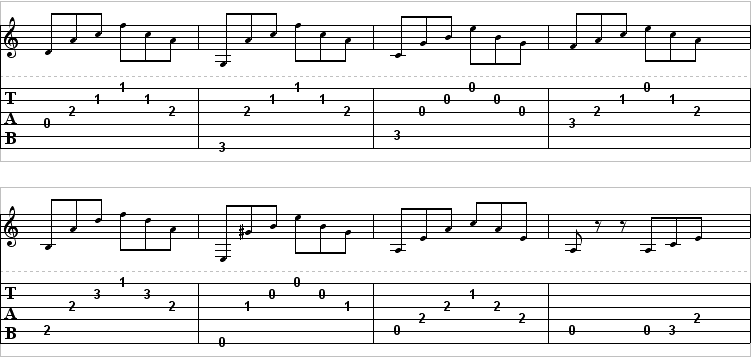
How To Play It
The second guitar part will provide excellent picking work. First, you will need to place your 1st finger barred over the “high E” string and the “B” string on the first frets. Then, use your 2nd finger to play
the second fret on the “G” string. These notes will be played in arpeggio style along with the rest of the riff for the second guitar part. Also, allow the “D” string to remain open for the opening note.
For the second measure, you will leave your 1st and 2nd fingers where they are, and either use your 3rd finger to play the third fret on the “low E” string, or you can use your thumb. It would be easier to use your 3rd finger if you can, as you will see in the next measure. For this next measure, you will need to place your 3rd finger on the “A” string on the third fret. Play that once, and don’t forget about the open notes being played in the same pattern.
For the fourth measure, you will need to place your 3rd finger on the third fret on the “D” string. Next, place your 1st finger on the first fret on the “B” string, and place your 2nd finger on the second fret on the “G” string. Play accordingly and proceed.
Start the 5th measure by placing your 1st finger on the first fret on the “high E” string. Place your 2nd finger on the second fret on the “G” string, and then place your 3rd finger on the third fret on the “B” string. Also, you will need to play the second fret on the “A” string with your thumb. Try to wrap it over the neck and only strike the “A” string, avoiding the “low E” string at all costs. If you can do this then
you will have no trouble making it sound right.
In the sixth measure, you will use your 1st finger to play the “B” string, allowing all the other notes to play as well. This will transition you into the next measure much easier.
For the seventh measure, just keep your 1st finger where it was before, and add your 2nd finger to the second fret on the “D” string, and your 3rd finger to the second fret on the “G” string. Leave the “A” string open and you just played an Am chord.
In the last measure of this part, you will be playing what appears to be almost a C chord. Here, just use your 3rd finger to play the third fret on the “A” string and use your 2nd finger to play the second fret on the “D” string. Don’t forget to play the open notes at the beginning of the measure.
Bass Guitar
The bass part on this is pretty fun. To begin the measure, use your 3rd or 4th finger to play the fifth fret on the “A” string. Then, use your 1st finger to play the third fret on the “E” string. Move to the “A” string
and play the third fret again with your 1st finger. Next, just move to the first fret on the “E” string and play it with your 1st finger. After that, you can either play the third fret on the “D” string with your
3rd or 4th finger, and then just use your 2nd or 3rd finger to play the second fret on the same string. For the fifth measure, use your 2nd finger to play the “A” string on the second fret, and then just move the same finger on the same fret to the “D” string for the next measure.
Move back down again to the second fret on the “A” string, and then use your 3rd finger to play the third fret on the “E” string to end the measure. Next, move to the fifth fret with either your 3rd or 4th
finger and play the “E” string. Then play the second fret on the “D” string with your 1st finger, and then follow up with your 2nd finger on the third fret on the “A” string. End this part by playing the fifth fret on the “E” string twice with your 1st finger, and then use your 3rd or 4th finger to play the eighth fret on the same string. Last, you can use your 2nd or 3rd finger to play the seventh fret on the “A” string.
Verse
Here’s what both the bass and guitar sound like together:
Guitar
The verse from Still Got The Blues is played identically to the second guitar part, but notice that in a few instances, you will not be picking the notes out, such as in the seventh measure when you are to play the first and second frets together. This isn’t TOO noticeable, but it does make a difference in the way it sounds.
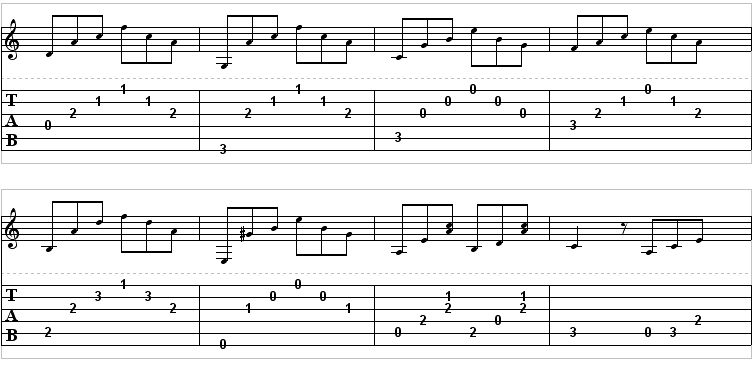
Bass Guitar
The bass guitar part for the verse is very similar to the part played during
the intro solo:

Solo 1
Below is what the rhythm guitar, bass, and lead guitar sound like together. The rhythm guitar and bass play the same parts as from the verse.
Lead Guitar
For the first measure of the solo, notice that it is the same as the first guitar part. This is also the case as with the third measure, the fourth measure, and the fifth measure. For the second measure, you will need to play it much the same as the second measure of the first guitar part, but there is an added
slide on the twelfth fret on the “G” string. You can use your 2nd finger for this if you wish. Use your 2nd finger to play the twelfth fret on the “B” string, and then play the tenth fret with your 1st finger
on the same string. After that, use your 2nd finger again on the twelfth fret on the “G” string this time and bend it 1/4 to the sound of the audio. The next two measures are self-explanatory, and are relative to the notes we already covered.
